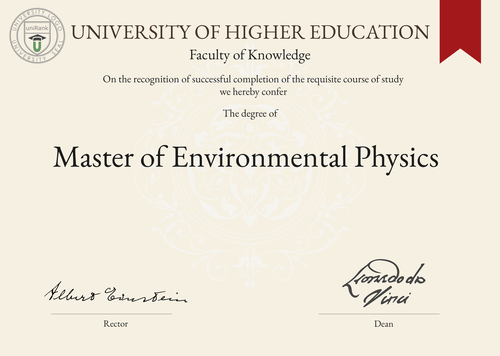
Master of Environmental Physics (MEnvPhys)
Guide to Master of Environmental Physics Program/Course/Degree
Master of Environmental Physics (MEnvPhys)

Program Name
Master of Environmental PhysicsProgram or Degree abbreviation
MEnvPhysDuration range
The duration of the program typically ranges from 1 to 2 years, depending on the university and country.Tuition range
Tuition fees for the Master of Environmental Physics program vary depending on the university and country. It is recommended to check with specific institutions for accurate information.Overview
The Master of Environmental Physics program is designed to provide students with a comprehensive understanding of the physical processes that govern the environment. It combines principles from physics, atmospheric science and environmental science to address complex environmental challenges.Curriculum Overview by year
The curriculum of the Master of Environmental Physics program is structured to cover a wide range of topics. The following is a general overview of the curriculum by year: Year 1: - Introduction to Environmental Physics - Atmospheric Physics - Environmental Measurements and Instrumentation - Climate Change and Global Warming - Environmental Modeling Year 2: - Air Pollution and Control - Renewable Energy Systems - Environmental Impact Assessment - Water Resources and Management - Research ProjectKey Components
Key components of the Master of Environmental Physics program include: - Understanding the fundamental principles of physics and their application to environmental systems - Developing skills in environmental measurements and instrumentation - Analyzing and modeling environmental processes - Exploring the impact of human activities on the environment - Investigating strategies for mitigating environmental challengesCareer Prospects
Graduates of the Master of Environmental Physics program have various career prospects, including: - Environmental consultant - Climate change analyst - Air quality specialist - Renewable energy researcher - Environmental policy advisor - Environmental scientistSalary Expectations
Salary expectations for individuals with a Master of Environmental Physics degree can vary depending on factors such as location, industry and level of experience. Generally, graduates can expect competitive salaries in the field, with potential for growth as they gain more experience. For a more accurate understanding of salary expectations, you can utilize the Job Sites Search Engine, from our sister site jobRank, which searches over 4,600 job sites worldwide. Make sure to specify not only the job title but also the country you are interested in.Conclusions:
It is important to note that the duration, tuition fees, curriculum, key components, career prospects and salary expectations of the Master of Environmental Physics program can vary: a) by the chosen country or location where to study the program b) by the chosen university where to study the program Visitors interested in pursuing this specific degree can use the uniRank World Universities Search Engine to find universities offering the Master of Environmental Physics program worldwide. This tool allows individuals to explore different options and make informed decisions about their education and future career.World Universities Search Engine
search for Master of Environmental Physics (MEnvPhys) and add the Location (country, state etc.) or specific University you are interested in studying at.
Query examples:
- Master of Environmental Physics (MEnvPhys) United States
- Master of Environmental Physics (MEnvPhys) United Kingdom online
- Master of Environmental Physics (MEnvPhys) Australia international students
- Master of Environmental Physics (MEnvPhys) University of California
- Master of Environmental Physics (MEnvPhys) University of London tuition fees
- Master of Environmental Physics (MEnvPhys) University of Sydney scholarships
Share Program/Course
Interesting? Share this program/course/degree info with your friends now.